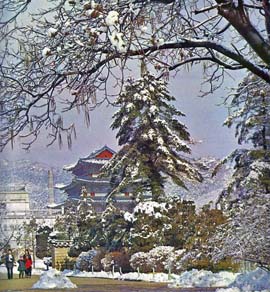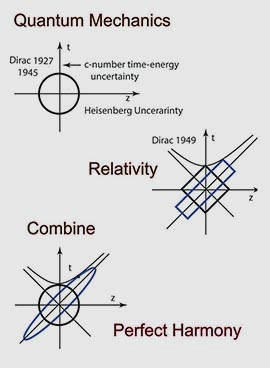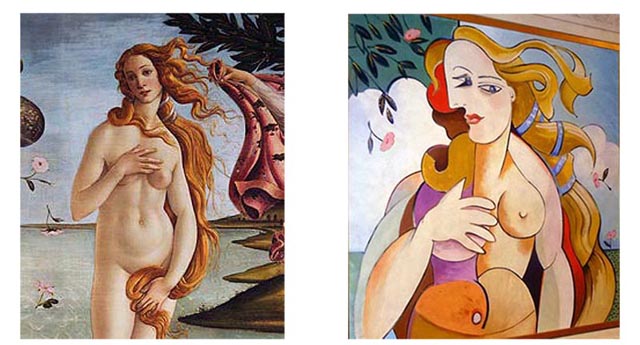Harmony in Architecture and Harmony in Physics
During the Renaissance period, Italian architects were interested in constructing useful buildings by combining Greek and Romanesque styles. The aesthetic value of Greek style was well appreciated. Romans figured out vector division of forces and were able to build domes and arches without supporting poles in the middle.- Yes, the first step to this approach would be to construct rotundas,
with Greek columns and Roman roofs.
Indeed, Italians built many rotundas in and near the city of Vicenza not far from Venice. Thomas Jefferson of the United States was a talented architect and reproduced this idea to build his own villa in this Renaissance style. The Thomas Jefferson Memorial in Washington, built in 1937, is modelled after the Rotunda on the campus of the University of Virginia in in Charlottesville.
Here are detailed views of the Jefferson Memorial.
- Jefferson Memorial (front view)
- (side view)
- (rear view)
- Click here for photos of Jefferson's villa called Monticello in Charlottesville.

- Jefferson Memorial (front view)
- Let us go back to Italy. The Renaissance artists started with this
simple combination. The person who created this new trend was
Andrea Palladio. I went to Vicenza (Italy) during the
last week of May (2008) to learn how Palladio was so creative. He
did not invent his Palladio style overnight.
He gradually developed his creativity from the simple idea of rotunda
to his masterpiece
called Basilica Palladiana. This photo is from one of the guidebooks
for the Veneto region.
In looking at artworks, each individual has his/her own subjective way influenced by his/her cultural background. It was very clear to me that Palladio's main concern was how to achieve a "harmony" between the Greek and Roman traditions.
- We say Pablo Picasso was a
great artist. Why? If we look at a beautiful
woman, we appreciate God's ability to combine eyes, lips, nose, and others
in a harmonious manner. Picasso wanted to create his own harmony. He
divided up all those components and then put them into different places
to create his own harmony.
Sandro Botticelli's Venus is well known. It was constructed during the Renaissance period. There is another version of Venus presumably after Picasso. I do not think this version of Venus is Picasso's work. However, this painting illustrates quite vividly Picasso's ideology. Click here for a story. I spotted this painting at the Caesar Palace in Las Vegas, U.S.A. (2012).
- I seem to emphasize the "harmony" as an important variable in
architecture (it is an important variable in music). Does this have
anything to do with my Korean background? Perhaps Yes. Perhaps No.
In either case, let us look at some photos of Korean architecture.
- Korean Architecture. Harmony with nature.
- Another Photo in harmony with nature.
- This Simple Structure in Pyongyang is an integral component of nature. Korea used to be and still is one country sharing the same cultural heritage.

Unlike those European cathedrals, Korean houses and buildings do not stand out. It is very difficult to extract artistic values from them. Right? Wrong! The strength of Korean architecture is its harmony with nature. I can of course talk more about its historical origin, but let me stop here.
- How about harmony in physics? Whenever there is a great breakthrough,
it is accompanied by a harmonious union of two or more existing
disciplines.
- Newton was able to combine comets (open orbits) and planets
(bound orbits) into one equation of motion.
Einstein's
Observation
Galilean
LorentzianNewtonian
Mechanics
Yes
NoMaxwell's
E & M
No
Yes - Maxwell was able to unify electricity and magnetism to
formulate electomagnetism, responsible for today's
wireless world.
- Einstein observed this mismatch between mechanics and electromagnetism
and fixed the problem to formulate the principle of relativity
- Heisenberg came up with his uncertainty priciple in an attempt to
achieve a harmony between the particle nature and wave nature of matter.
- How about Feynman? He believed in "one physics."
The first step could be to translate both quantum mechanics and relativity into pictures.
- In 1927, Paul A. M. Dirac noted there is an uncertainty relation
between the time and energy variables, in addition to Heisenberg's
position-momentum uncertainty relation. Dirac noted further that
there are no excitations along the time axis.
- In 1949, Dirac proposed the light-cone coordinate system to study
coordinate transformations for Einstein's special relativity. In this
system a square becomes squeezed into a rectangle.
- However, Dirac did not draw pictures of what he was doing. He
thus assigned very interesting homework problems for us.
- If we translate Dirac's observations, we end up with this figure. Click here for a detailed explanation. The picture drawing culture was introduced to physics by Wheeler and Feynman.

Click here to magnify this figure. Indeed, pictures and their harmony constitute a very powerful language in creating physics, in the tradition of Andrea Palladio.
- Newton was able to combine comets (open orbits) and planets
(bound orbits) into one equation of motion.

|
Who is responsible for this webpage?
Click here for his home page. or
click here for his style page.
copyright@2014 by Y. S. Kim, unless otherwise specified.
